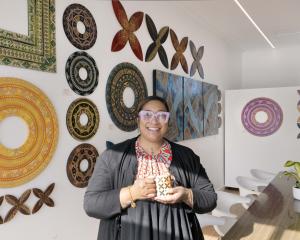
‘‘Oamaru Belles'', Donna Demente and Katherine Kovacs (The Artist's Room)
Donna Demente is undoubtedly one of Oamaru's best-known artists, and her work is both popular with and familiar to Dunedin audiences.
In the current exhibition at The Artist's Room, her work is paired with that of another accomplished Oamaru portraitist, Katherine Kovacs.
Demente's close-up portraits have a strong, wistful appeal.
In the current exhibition the artist has ventured somewhat from her normal Renaissance-inspired pieces, each housed within its altarpiece frame, though these works are still present.
Accompanying them are intriguing pieces forging new territory: Genetic Selection Catalogue with its combination of collage and mask is a strong departure from Demente's normal work, as is the bold circular frame and closely cropped image of Sophie.
The artist has also produced a series of miniature cameos, each focusing on her painted obsession, the eye.
Kovacs' work sits boldly and comfortably alongside Demente's as a perfect complement to it.
Like her fellow Oamaruvian, she creates memorable frames to enhance her subjects, in this case largely constructed from former Oamaru Opera House seat backs.
The portraits are fine pieces with an air of slight melancholy, several of the costumes and faces suggesting the golden era of silent movies.
The works are impressive, especially the haunting Red Cross, a piece which hints at a dark narrative.

‘‘Nature Watch'', Jo Ogier and Marilynn Webb (Inge Doesburg Gallery)
Just down the road from the Artist's Room, at the Inge Doesburg Gallery, another two-woman show is in progress.
In this exhibition, though, the emphasis is on a portrait of the land and the wildlife which inhabits it.
‘‘Nature Watch'' contains work by Jo Ogier and Marilynn Webb, two artists whose work is deeply concerned with ecology and the environment, and on the human impact on the natural world.
Marilynn Webb's work is justifiably well known, its pastels and prints depicting the empty spaces of the country's wilderness areas and weaving allegorical circular designs based on the stories of our rivers.
Her work makes a strong connection between the artist and the landscape, and draws us into spaces, whether in the open watercolour skies of Summer snow, West Otago or the rich depths of her Fiordland scenes.
Jo Ogier returns to the gallery which she helped found, and complements the work of her former teacher with a series of fine prints of birds, insects, mammals, and seed packets, many of them printed on organic woven paper.
Images such as the majestic flying godwit and the perched karearea against a weave of flax are memorable, as is the wry commentary supplied by the dog-tags indicating those transtasman arrivals, the magpie and the wallaby.

‘‘Otago Art Society Summer Exhibition'' (The Art Station)
The Otago Art Society's galleries are filled with more than 150 works, for the society's summer exhibition.
As always with such a display, there is a diversity of styles, media, and subjects, with many interesting pieces.
Compared with recent displays, this exhibition is relatively devoid of portraits, their place largely taken by abstracts.
As is usual, landscapes dominate, ranging across many styles.
Photorealistic works by Annie Pepers, Anne Baldock and Alastair Begg stand out, as do Andrew Cook's moody mountainscape and striking watercolours by Maurice Middleditch.
Raimo Kuparinen's cleverly framed view and Jenny Longstaff's impressive photomanipulation are also of note.
More impressionistic items by Judy Smith and Pauline Durning are fine pieces, as is a moody work by Pauline Bellamy for which she won second prize.
Two semi-abstract works gained the other main prizes.
First was Jude Ansbacher with a heavily stylised image of a pool, praised by judge David Bell for its energy and hazy atmospherics.
Third went to June Harris' Scarlet Schist, a work combining impressions of land with close-up study of rock crystals.
Pieces by Karin Werner, Manu Berry, and Jane Trotter also held the attention, as did a lovely op-art piece by Brian Stewart.
Kate Springford's playful sculpture and other ceramics by Suzanne Emslie and Danny Moorwood were also eye-catching.












